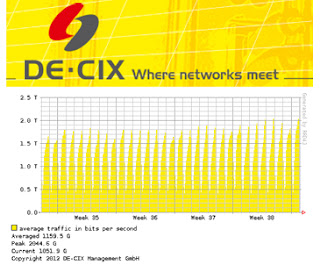DE-CIX, the world's largest Internet Exchange serving over 480 Internet service providers via a distributed peering fabric in Frankfurt, Germany, will upgrade its metro network to 100G channels using ADVA Optical Networking's FSP 3000 platform.
DE-CIX hit a new data throughput record last week as Internet traffic across its switching fabric exceeded the 2 Tbps (terabits per second) mark for the first time.
The DE-CIX peering infrastructure has a star-shaped topology and is spread out over a total of twelve data centers operated by different providers in the Frankfurt metropolitan area. The current 10G DWDM metro network is being upgraded to 100G channels.
ADVA said its100G Metro solution is built on 4x28G direct detection technology delivering four key efficiencies: cost, space, power and spectral.
"We're seeing a continuous increase in data traffic with a growth rate of about 80% every year, an increase that shows no signs of slowing down," said Arnold Nipper, CTO at DE-CIX. "To meet this enormous surge in data it's critical that we migrate the core of our network. What's more, we need to do so in the most seamless manner possible. We have a record of 100% uptime and this is something we cannot risk. ADVA Optical Networking’s 100G Metro enables us to migrate our current 10G services while at the same time adding 100G capacity in the simplest manner possible. But it's the small footprint and the low power consumption of theADVA solution that make all the difference: ADVA Optical Networking is simply the only vendor out there with 100G in this form factor."
"DE-CIX is faced with aggressive data demands," said Detlev Schmidt, head of the AXIANS Business Unit Carrier & Service Provider. "Serving over 480 customers from more than 50 countries places unprecedented strains on its core network. To ensure that it can meet its customer expectations and scale for future growth, we're helping DE-CIX to build one of the most advanced networks of its kind. Centered upon the ADVA FSP 3000, DE-CIX is building its core infrastructure on a firm foundation: A 100G Metro foundation that has already been tested in some of the most demanding network environments."
- Equipment deployed in the DE-CIX distributed fabric includes Force10 Networks' Terascale platform.
 ConceptWave, which is based in Toronto, Canada, has developed Product Lifecycle Management, Order Lifecycle Management and Customer Lifecycle Management solutions for service providers. The company was founded in 2000 and has about 170 employees.
ConceptWave, which is based in Toronto, Canada, has developed Product Lifecycle Management, Order Lifecycle Management and Customer Lifecycle Management solutions for service providers. The company was founded in 2000 and has about 170 employees.
















